Impact of CSR Activities on Consumer Buying Behavior: Cosmetics
VerifiedAdded on 2020/01/23
|60
|19831
|42
Report
AI Summary
This report investigates the significant role of Corporate Social Responsibility (CSR) activities in shaping consumer buying behavior within the UK cosmetic industry. The study explores the concept of CSR, its principles, theories, and dimensions, specifically within the context of cosmetic companies. It examines the CSR practices of cosmetic industries in the UK, analyzing the relationship between these activities and consumer purchasing decisions. The research employs a comprehensive methodology including literature review, research design, and data analysis to ascertain how CSR impacts consumer choices. The report aims to identify and recommend effective strategies for cosmetic companies to enhance their CSR initiatives, ultimately improving consumer engagement and boosting sales. Findings emphasize the growing importance of ethical considerations and sustainable practices in influencing consumer preferences and brand loyalty within the competitive cosmetic market.
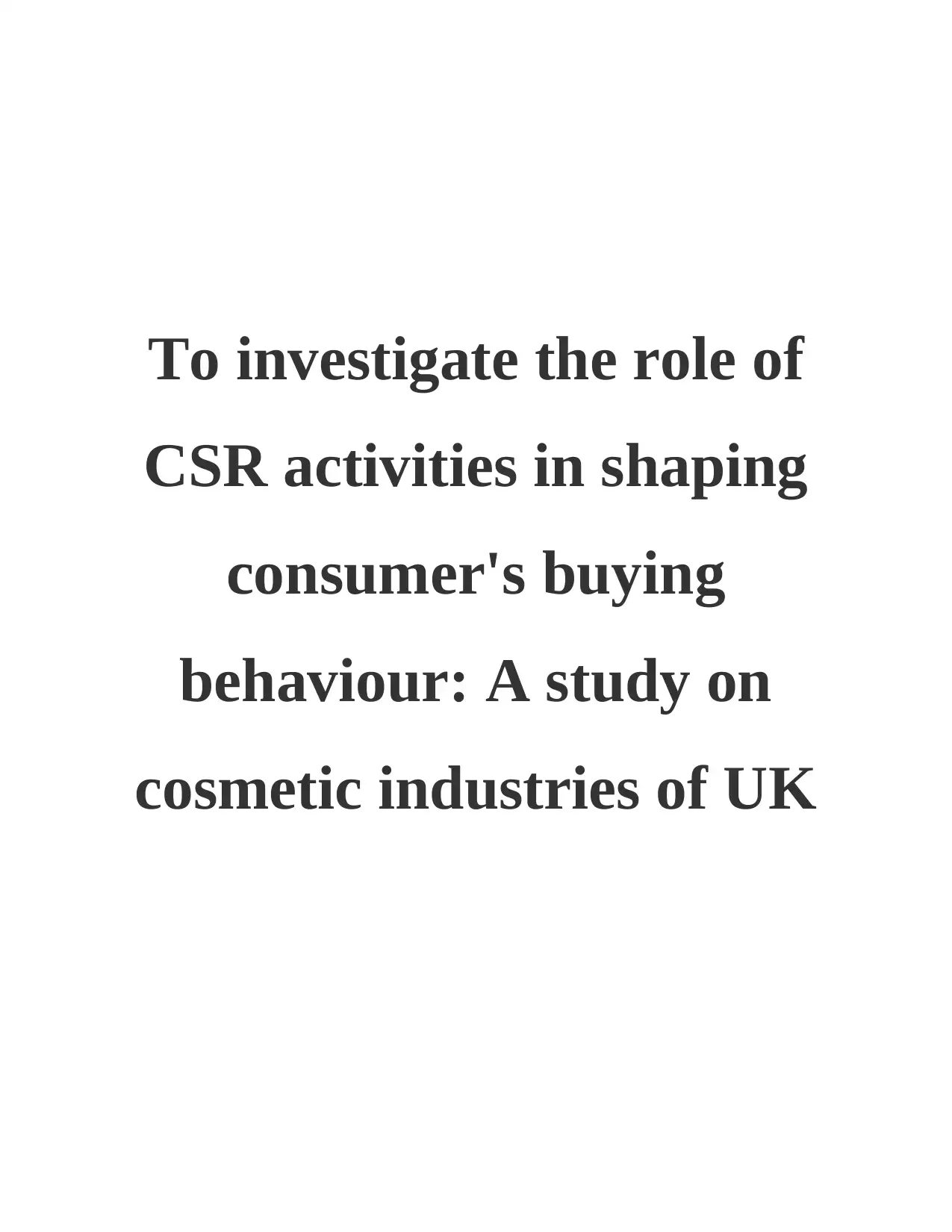
To investigate the role of
CSR activities in shaping
consumer's buying
behaviour: A study on
cosmetic industries of UK
CSR activities in shaping
consumer's buying
behaviour: A study on
cosmetic industries of UK
Paraphrase This Document
Need a fresh take? Get an instant paraphrase of this document with our AI Paraphraser
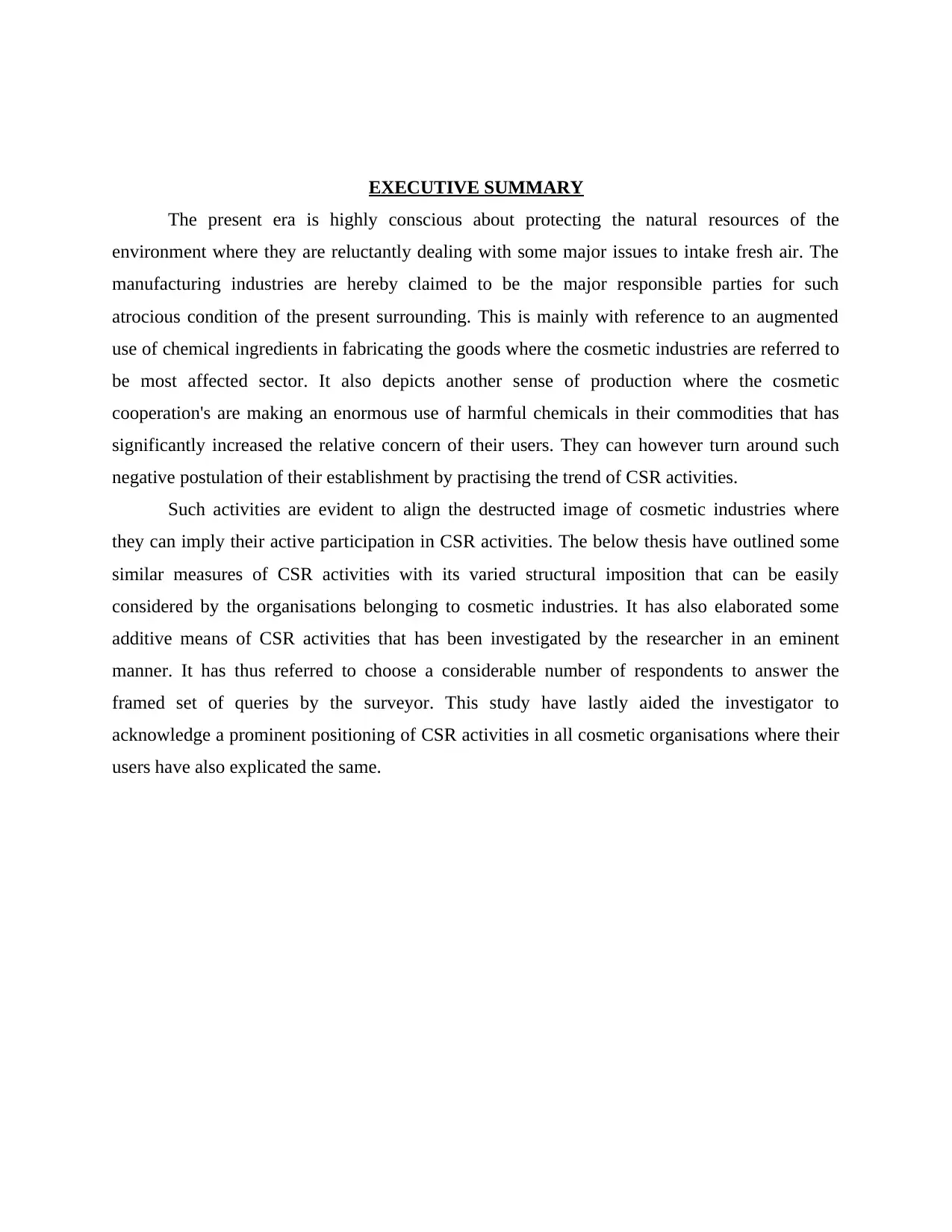
EXECUTIVE SUMMARY
The present era is highly conscious about protecting the natural resources of the
environment where they are reluctantly dealing with some major issues to intake fresh air. The
manufacturing industries are hereby claimed to be the major responsible parties for such
atrocious condition of the present surrounding. This is mainly with reference to an augmented
use of chemical ingredients in fabricating the goods where the cosmetic industries are referred to
be most affected sector. It also depicts another sense of production where the cosmetic
cooperation's are making an enormous use of harmful chemicals in their commodities that has
significantly increased the relative concern of their users. They can however turn around such
negative postulation of their establishment by practising the trend of CSR activities.
Such activities are evident to align the destructed image of cosmetic industries where
they can imply their active participation in CSR activities. The below thesis have outlined some
similar measures of CSR activities with its varied structural imposition that can be easily
considered by the organisations belonging to cosmetic industries. It has also elaborated some
additive means of CSR activities that has been investigated by the researcher in an eminent
manner. It has thus referred to choose a considerable number of respondents to answer the
framed set of queries by the surveyor. This study have lastly aided the investigator to
acknowledge a prominent positioning of CSR activities in all cosmetic organisations where their
users have also explicated the same.
The present era is highly conscious about protecting the natural resources of the
environment where they are reluctantly dealing with some major issues to intake fresh air. The
manufacturing industries are hereby claimed to be the major responsible parties for such
atrocious condition of the present surrounding. This is mainly with reference to an augmented
use of chemical ingredients in fabricating the goods where the cosmetic industries are referred to
be most affected sector. It also depicts another sense of production where the cosmetic
cooperation's are making an enormous use of harmful chemicals in their commodities that has
significantly increased the relative concern of their users. They can however turn around such
negative postulation of their establishment by practising the trend of CSR activities.
Such activities are evident to align the destructed image of cosmetic industries where
they can imply their active participation in CSR activities. The below thesis have outlined some
similar measures of CSR activities with its varied structural imposition that can be easily
considered by the organisations belonging to cosmetic industries. It has also elaborated some
additive means of CSR activities that has been investigated by the researcher in an eminent
manner. It has thus referred to choose a considerable number of respondents to answer the
framed set of queries by the surveyor. This study have lastly aided the investigator to
acknowledge a prominent positioning of CSR activities in all cosmetic organisations where their
users have also explicated the same.
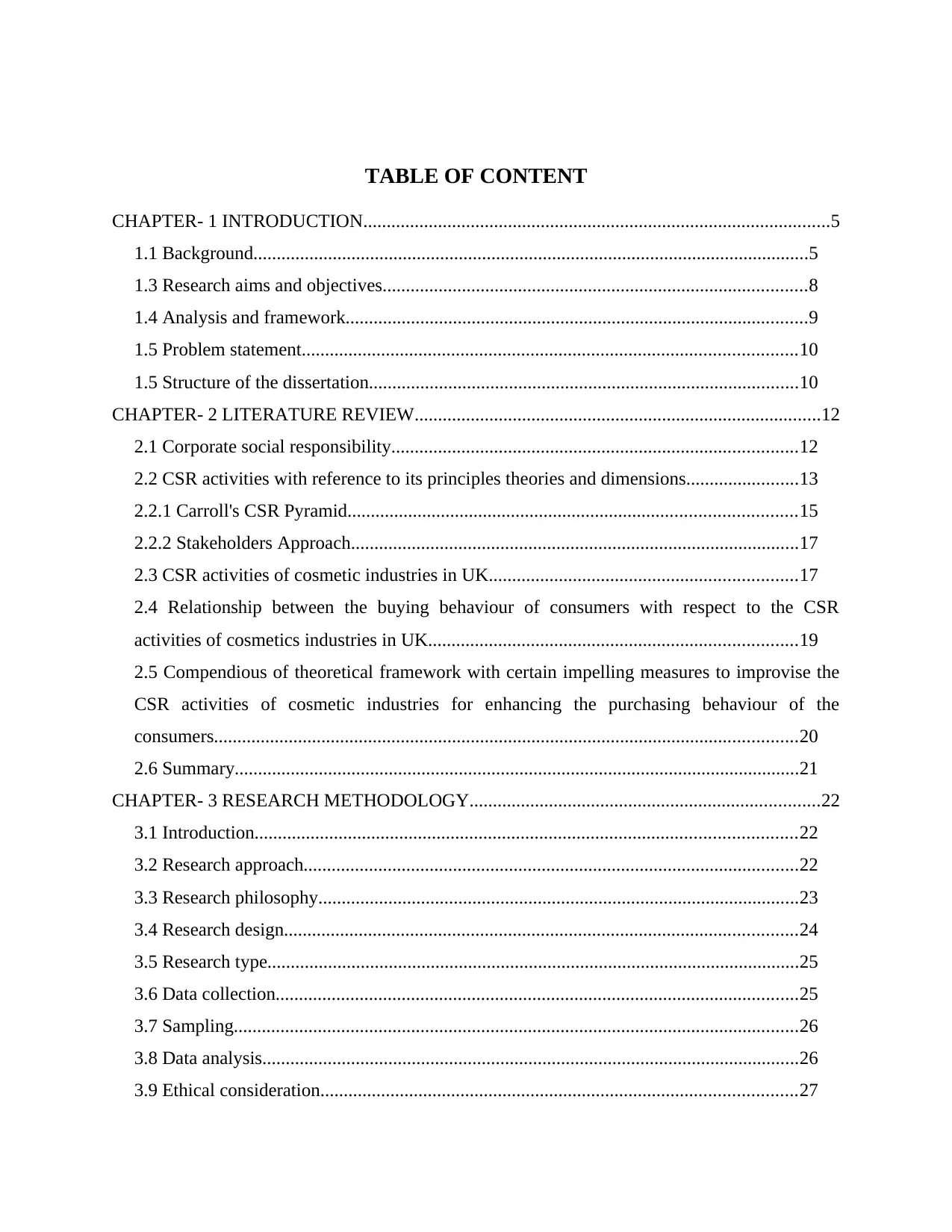
TABLE OF CONTENT
CHAPTER- 1 INTRODUCTION....................................................................................................5
1.1 Background.......................................................................................................................5
1.3 Research aims and objectives...........................................................................................8
1.4 Analysis and framework...................................................................................................9
1.5 Problem statement..........................................................................................................10
1.5 Structure of the dissertation............................................................................................10
CHAPTER- 2 LITERATURE REVIEW.......................................................................................12
2.1 Corporate social responsibility.......................................................................................12
2.2 CSR activities with reference to its principles theories and dimensions........................13
2.2.1 Carroll's CSR Pyramid................................................................................................15
2.2.2 Stakeholders Approach................................................................................................17
2.3 CSR activities of cosmetic industries in UK..................................................................17
2.4 Relationship between the buying behaviour of consumers with respect to the CSR
activities of cosmetics industries in UK...............................................................................19
2.5 Compendious of theoretical framework with certain impelling measures to improvise the
CSR activities of cosmetic industries for enhancing the purchasing behaviour of the
consumers.............................................................................................................................20
2.6 Summary.........................................................................................................................21
CHAPTER- 3 RESEARCH METHODOLOGY...........................................................................22
3.1 Introduction....................................................................................................................22
3.2 Research approach..........................................................................................................22
3.3 Research philosophy.......................................................................................................23
3.4 Research design..............................................................................................................24
3.5 Research type..................................................................................................................25
3.6 Data collection................................................................................................................25
3.7 Sampling.........................................................................................................................26
3.8 Data analysis...................................................................................................................26
3.9 Ethical consideration......................................................................................................27
CHAPTER- 1 INTRODUCTION....................................................................................................5
1.1 Background.......................................................................................................................5
1.3 Research aims and objectives...........................................................................................8
1.4 Analysis and framework...................................................................................................9
1.5 Problem statement..........................................................................................................10
1.5 Structure of the dissertation............................................................................................10
CHAPTER- 2 LITERATURE REVIEW.......................................................................................12
2.1 Corporate social responsibility.......................................................................................12
2.2 CSR activities with reference to its principles theories and dimensions........................13
2.2.1 Carroll's CSR Pyramid................................................................................................15
2.2.2 Stakeholders Approach................................................................................................17
2.3 CSR activities of cosmetic industries in UK..................................................................17
2.4 Relationship between the buying behaviour of consumers with respect to the CSR
activities of cosmetics industries in UK...............................................................................19
2.5 Compendious of theoretical framework with certain impelling measures to improvise the
CSR activities of cosmetic industries for enhancing the purchasing behaviour of the
consumers.............................................................................................................................20
2.6 Summary.........................................................................................................................21
CHAPTER- 3 RESEARCH METHODOLOGY...........................................................................22
3.1 Introduction....................................................................................................................22
3.2 Research approach..........................................................................................................22
3.3 Research philosophy.......................................................................................................23
3.4 Research design..............................................................................................................24
3.5 Research type..................................................................................................................25
3.6 Data collection................................................................................................................25
3.7 Sampling.........................................................................................................................26
3.8 Data analysis...................................................................................................................26
3.9 Ethical consideration......................................................................................................27
⊘ This is a preview!⊘
Do you want full access?
Subscribe today to unlock all pages.

Trusted by 1+ million students worldwide
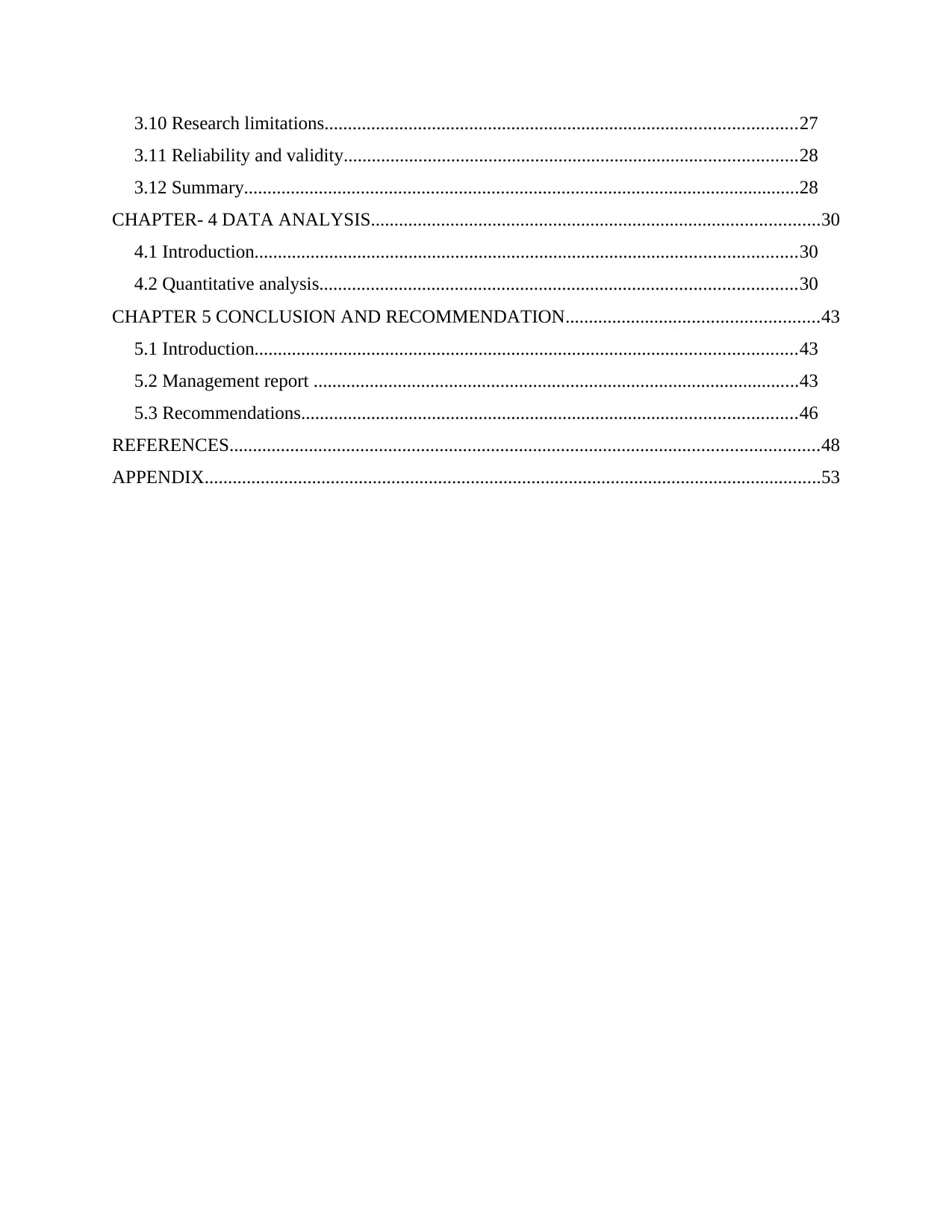
3.10 Research limitations.....................................................................................................27
3.11 Reliability and validity.................................................................................................28
3.12 Summary.......................................................................................................................28
CHAPTER- 4 DATA ANALYSIS................................................................................................30
4.1 Introduction....................................................................................................................30
4.2 Quantitative analysis......................................................................................................30
CHAPTER 5 CONCLUSION AND RECOMMENDATION......................................................43
5.1 Introduction....................................................................................................................43
5.2 Management report ........................................................................................................43
5.3 Recommendations..........................................................................................................46
REFERENCES..............................................................................................................................48
APPENDIX....................................................................................................................................53
3.11 Reliability and validity.................................................................................................28
3.12 Summary.......................................................................................................................28
CHAPTER- 4 DATA ANALYSIS................................................................................................30
4.1 Introduction....................................................................................................................30
4.2 Quantitative analysis......................................................................................................30
CHAPTER 5 CONCLUSION AND RECOMMENDATION......................................................43
5.1 Introduction....................................................................................................................43
5.2 Management report ........................................................................................................43
5.3 Recommendations..........................................................................................................46
REFERENCES..............................................................................................................................48
APPENDIX....................................................................................................................................53
Paraphrase This Document
Need a fresh take? Get an instant paraphrase of this document with our AI Paraphraser
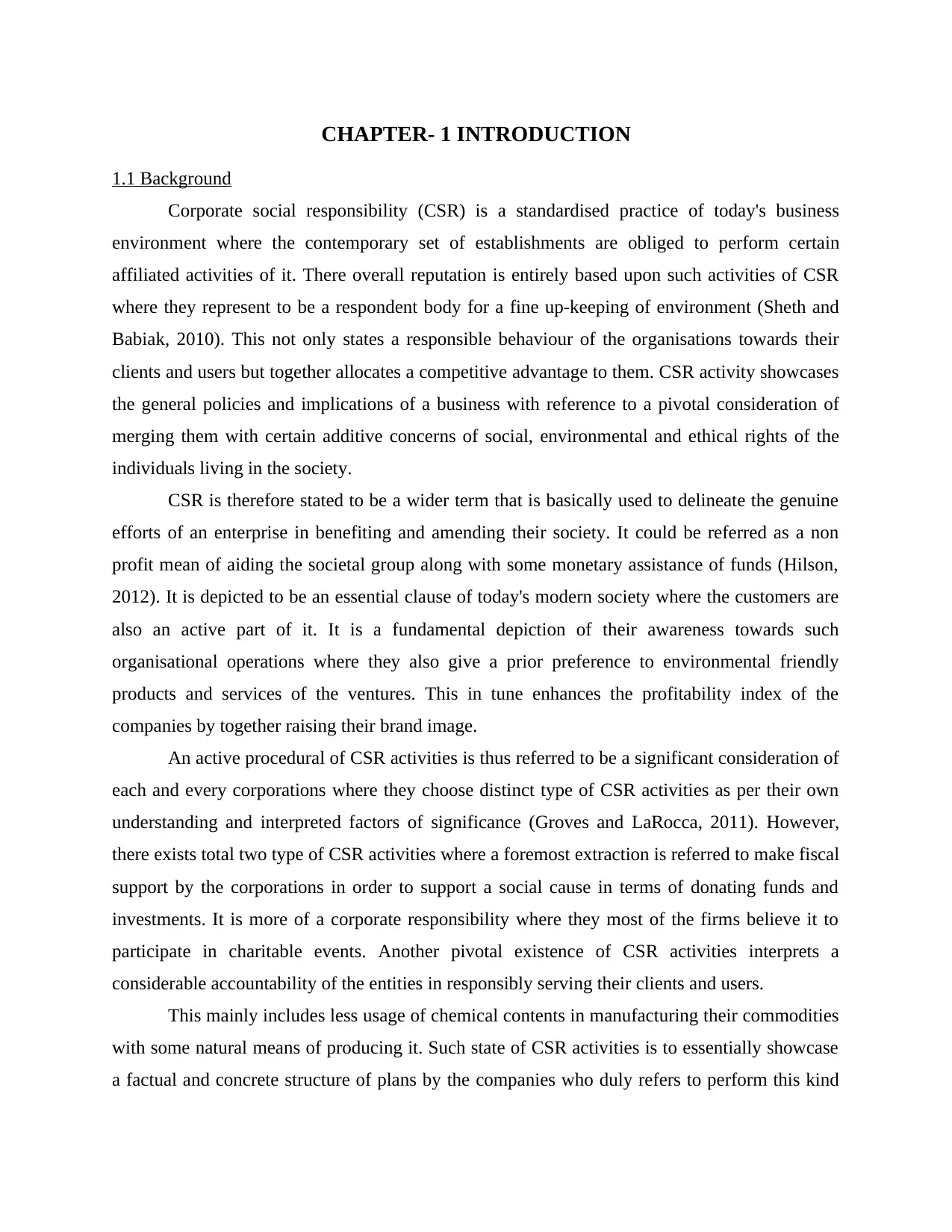
CHAPTER- 1 INTRODUCTION
1.1 Background
Corporate social responsibility (CSR) is a standardised practice of today's business
environment where the contemporary set of establishments are obliged to perform certain
affiliated activities of it. There overall reputation is entirely based upon such activities of CSR
where they represent to be a respondent body for a fine up-keeping of environment (Sheth and
Babiak, 2010). This not only states a responsible behaviour of the organisations towards their
clients and users but together allocates a competitive advantage to them. CSR activity showcases
the general policies and implications of a business with reference to a pivotal consideration of
merging them with certain additive concerns of social, environmental and ethical rights of the
individuals living in the society.
CSR is therefore stated to be a wider term that is basically used to delineate the genuine
efforts of an enterprise in benefiting and amending their society. It could be referred as a non
profit mean of aiding the societal group along with some monetary assistance of funds (Hilson,
2012). It is depicted to be an essential clause of today's modern society where the customers are
also an active part of it. It is a fundamental depiction of their awareness towards such
organisational operations where they also give a prior preference to environmental friendly
products and services of the ventures. This in tune enhances the profitability index of the
companies by together raising their brand image.
An active procedural of CSR activities is thus referred to be a significant consideration of
each and every corporations where they choose distinct type of CSR activities as per their own
understanding and interpreted factors of significance (Groves and LaRocca, 2011). However,
there exists total two type of CSR activities where a foremost extraction is referred to make fiscal
support by the corporations in order to support a social cause in terms of donating funds and
investments. It is more of a corporate responsibility where they most of the firms believe it to
participate in charitable events. Another pivotal existence of CSR activities interprets a
considerable accountability of the entities in responsibly serving their clients and users.
This mainly includes less usage of chemical contents in manufacturing their commodities
with some natural means of producing it. Such state of CSR activities is to essentially showcase
a factual and concrete structure of plans by the companies who duly refers to perform this kind
1.1 Background
Corporate social responsibility (CSR) is a standardised practice of today's business
environment where the contemporary set of establishments are obliged to perform certain
affiliated activities of it. There overall reputation is entirely based upon such activities of CSR
where they represent to be a respondent body for a fine up-keeping of environment (Sheth and
Babiak, 2010). This not only states a responsible behaviour of the organisations towards their
clients and users but together allocates a competitive advantage to them. CSR activity showcases
the general policies and implications of a business with reference to a pivotal consideration of
merging them with certain additive concerns of social, environmental and ethical rights of the
individuals living in the society.
CSR is therefore stated to be a wider term that is basically used to delineate the genuine
efforts of an enterprise in benefiting and amending their society. It could be referred as a non
profit mean of aiding the societal group along with some monetary assistance of funds (Hilson,
2012). It is depicted to be an essential clause of today's modern society where the customers are
also an active part of it. It is a fundamental depiction of their awareness towards such
organisational operations where they also give a prior preference to environmental friendly
products and services of the ventures. This in tune enhances the profitability index of the
companies by together raising their brand image.
An active procedural of CSR activities is thus referred to be a significant consideration of
each and every corporations where they choose distinct type of CSR activities as per their own
understanding and interpreted factors of significance (Groves and LaRocca, 2011). However,
there exists total two type of CSR activities where a foremost extraction is referred to make fiscal
support by the corporations in order to support a social cause in terms of donating funds and
investments. It is more of a corporate responsibility where they most of the firms believe it to
participate in charitable events. Another pivotal existence of CSR activities interprets a
considerable accountability of the entities in responsibly serving their clients and users.
This mainly includes less usage of chemical contents in manufacturing their commodities
with some natural means of producing it. Such state of CSR activities is to essentially showcase
a factual and concrete structure of plans by the companies who duly refers to perform this kind
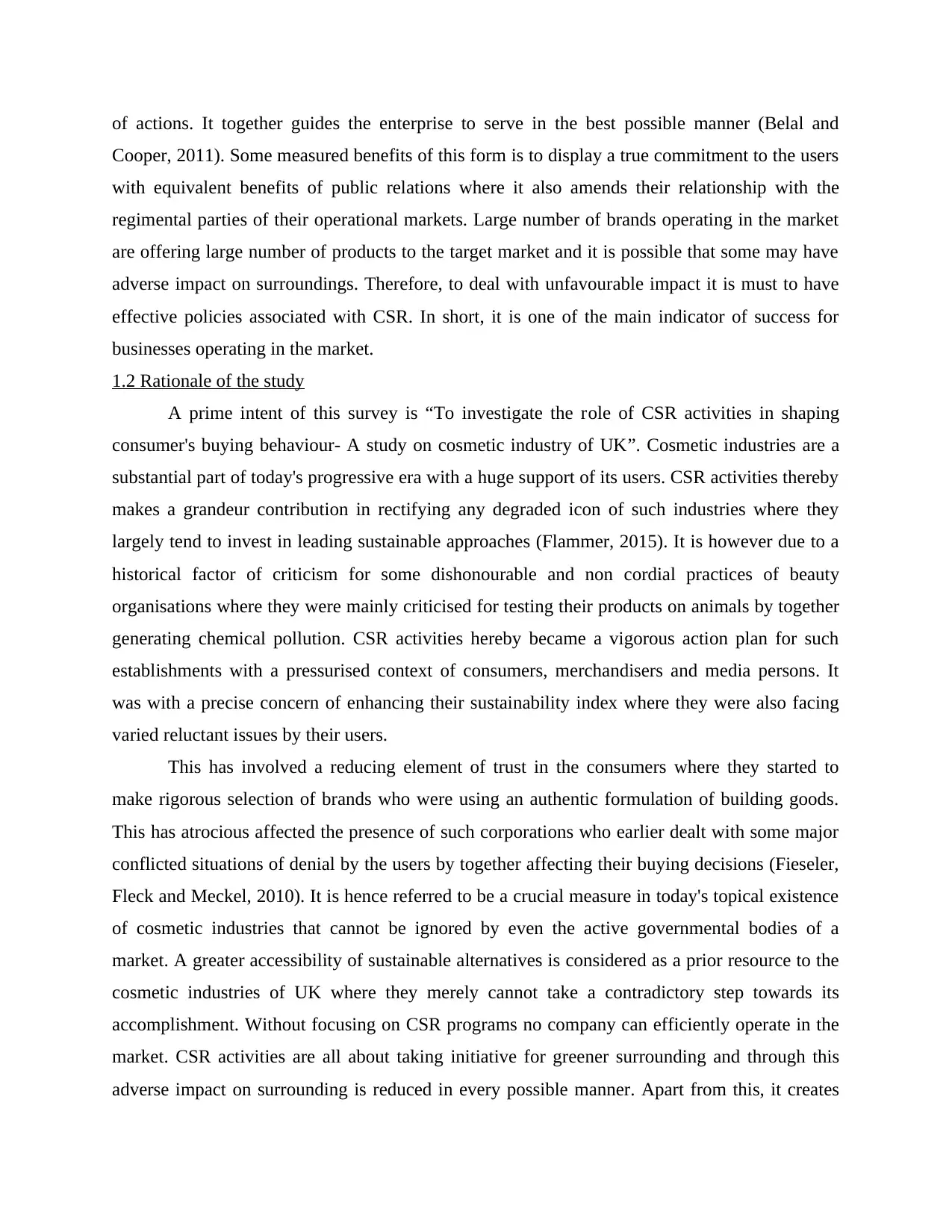
of actions. It together guides the enterprise to serve in the best possible manner (Belal and
Cooper, 2011). Some measured benefits of this form is to display a true commitment to the users
with equivalent benefits of public relations where it also amends their relationship with the
regimental parties of their operational markets. Large number of brands operating in the market
are offering large number of products to the target market and it is possible that some may have
adverse impact on surroundings. Therefore, to deal with unfavourable impact it is must to have
effective policies associated with CSR. In short, it is one of the main indicator of success for
businesses operating in the market.
1.2 Rationale of the study
A prime intent of this survey is “To investigate the role of CSR activities in shaping
consumer's buying behaviour- A study on cosmetic industry of UK”. Cosmetic industries are a
substantial part of today's progressive era with a huge support of its users. CSR activities thereby
makes a grandeur contribution in rectifying any degraded icon of such industries where they
largely tend to invest in leading sustainable approaches (Flammer, 2015). It is however due to a
historical factor of criticism for some dishonourable and non cordial practices of beauty
organisations where they were mainly criticised for testing their products on animals by together
generating chemical pollution. CSR activities hereby became a vigorous action plan for such
establishments with a pressurised context of consumers, merchandisers and media persons. It
was with a precise concern of enhancing their sustainability index where they were also facing
varied reluctant issues by their users.
This has involved a reducing element of trust in the consumers where they started to
make rigorous selection of brands who were using an authentic formulation of building goods.
This has atrocious affected the presence of such corporations who earlier dealt with some major
conflicted situations of denial by the users by together affecting their buying decisions (Fieseler,
Fleck and Meckel, 2010). It is hence referred to be a crucial measure in today's topical existence
of cosmetic industries that cannot be ignored by even the active governmental bodies of a
market. A greater accessibility of sustainable alternatives is considered as a prior resource to the
cosmetic industries of UK where they merely cannot take a contradictory step towards its
accomplishment. Without focusing on CSR programs no company can efficiently operate in the
market. CSR activities are all about taking initiative for greener surrounding and through this
adverse impact on surrounding is reduced in every possible manner. Apart from this, it creates
Cooper, 2011). Some measured benefits of this form is to display a true commitment to the users
with equivalent benefits of public relations where it also amends their relationship with the
regimental parties of their operational markets. Large number of brands operating in the market
are offering large number of products to the target market and it is possible that some may have
adverse impact on surroundings. Therefore, to deal with unfavourable impact it is must to have
effective policies associated with CSR. In short, it is one of the main indicator of success for
businesses operating in the market.
1.2 Rationale of the study
A prime intent of this survey is “To investigate the role of CSR activities in shaping
consumer's buying behaviour- A study on cosmetic industry of UK”. Cosmetic industries are a
substantial part of today's progressive era with a huge support of its users. CSR activities thereby
makes a grandeur contribution in rectifying any degraded icon of such industries where they
largely tend to invest in leading sustainable approaches (Flammer, 2015). It is however due to a
historical factor of criticism for some dishonourable and non cordial practices of beauty
organisations where they were mainly criticised for testing their products on animals by together
generating chemical pollution. CSR activities hereby became a vigorous action plan for such
establishments with a pressurised context of consumers, merchandisers and media persons. It
was with a precise concern of enhancing their sustainability index where they were also facing
varied reluctant issues by their users.
This has involved a reducing element of trust in the consumers where they started to
make rigorous selection of brands who were using an authentic formulation of building goods.
This has atrocious affected the presence of such corporations who earlier dealt with some major
conflicted situations of denial by the users by together affecting their buying decisions (Fieseler,
Fleck and Meckel, 2010). It is hence referred to be a crucial measure in today's topical existence
of cosmetic industries that cannot be ignored by even the active governmental bodies of a
market. A greater accessibility of sustainable alternatives is considered as a prior resource to the
cosmetic industries of UK where they merely cannot take a contradictory step towards its
accomplishment. Without focusing on CSR programs no company can efficiently operate in the
market. CSR activities are all about taking initiative for greener surrounding and through this
adverse impact on surrounding is reduced in every possible manner. Apart from this, it creates
⊘ This is a preview!⊘
Do you want full access?
Subscribe today to unlock all pages.

Trusted by 1+ million students worldwide
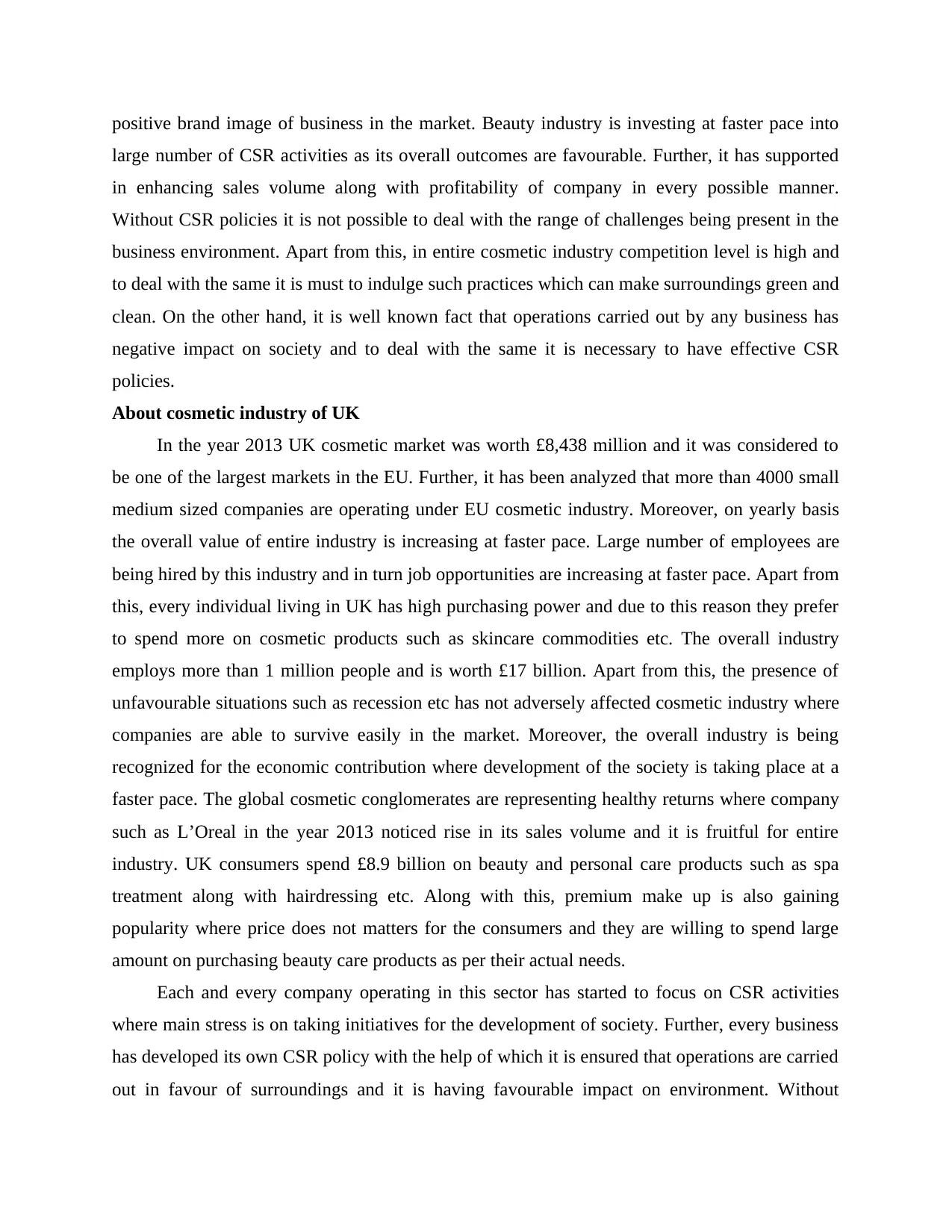
positive brand image of business in the market. Beauty industry is investing at faster pace into
large number of CSR activities as its overall outcomes are favourable. Further, it has supported
in enhancing sales volume along with profitability of company in every possible manner.
Without CSR policies it is not possible to deal with the range of challenges being present in the
business environment. Apart from this, in entire cosmetic industry competition level is high and
to deal with the same it is must to indulge such practices which can make surroundings green and
clean. On the other hand, it is well known fact that operations carried out by any business has
negative impact on society and to deal with the same it is necessary to have effective CSR
policies.
About cosmetic industry of UK
In the year 2013 UK cosmetic market was worth £8,438 million and it was considered to
be one of the largest markets in the EU. Further, it has been analyzed that more than 4000 small
medium sized companies are operating under EU cosmetic industry. Moreover, on yearly basis
the overall value of entire industry is increasing at faster pace. Large number of employees are
being hired by this industry and in turn job opportunities are increasing at faster pace. Apart from
this, every individual living in UK has high purchasing power and due to this reason they prefer
to spend more on cosmetic products such as skincare commodities etc. The overall industry
employs more than 1 million people and is worth £17 billion. Apart from this, the presence of
unfavourable situations such as recession etc has not adversely affected cosmetic industry where
companies are able to survive easily in the market. Moreover, the overall industry is being
recognized for the economic contribution where development of the society is taking place at a
faster pace. The global cosmetic conglomerates are representing healthy returns where company
such as L’Oreal in the year 2013 noticed rise in its sales volume and it is fruitful for entire
industry. UK consumers spend £8.9 billion on beauty and personal care products such as spa
treatment along with hairdressing etc. Along with this, premium make up is also gaining
popularity where price does not matters for the consumers and they are willing to spend large
amount on purchasing beauty care products as per their actual needs.
Each and every company operating in this sector has started to focus on CSR activities
where main stress is on taking initiatives for the development of society. Further, every business
has developed its own CSR policy with the help of which it is ensured that operations are carried
out in favour of surroundings and it is having favourable impact on environment. Without
large number of CSR activities as its overall outcomes are favourable. Further, it has supported
in enhancing sales volume along with profitability of company in every possible manner.
Without CSR policies it is not possible to deal with the range of challenges being present in the
business environment. Apart from this, in entire cosmetic industry competition level is high and
to deal with the same it is must to indulge such practices which can make surroundings green and
clean. On the other hand, it is well known fact that operations carried out by any business has
negative impact on society and to deal with the same it is necessary to have effective CSR
policies.
About cosmetic industry of UK
In the year 2013 UK cosmetic market was worth £8,438 million and it was considered to
be one of the largest markets in the EU. Further, it has been analyzed that more than 4000 small
medium sized companies are operating under EU cosmetic industry. Moreover, on yearly basis
the overall value of entire industry is increasing at faster pace. Large number of employees are
being hired by this industry and in turn job opportunities are increasing at faster pace. Apart from
this, every individual living in UK has high purchasing power and due to this reason they prefer
to spend more on cosmetic products such as skincare commodities etc. The overall industry
employs more than 1 million people and is worth £17 billion. Apart from this, the presence of
unfavourable situations such as recession etc has not adversely affected cosmetic industry where
companies are able to survive easily in the market. Moreover, the overall industry is being
recognized for the economic contribution where development of the society is taking place at a
faster pace. The global cosmetic conglomerates are representing healthy returns where company
such as L’Oreal in the year 2013 noticed rise in its sales volume and it is fruitful for entire
industry. UK consumers spend £8.9 billion on beauty and personal care products such as spa
treatment along with hairdressing etc. Along with this, premium make up is also gaining
popularity where price does not matters for the consumers and they are willing to spend large
amount on purchasing beauty care products as per their actual needs.
Each and every company operating in this sector has started to focus on CSR activities
where main stress is on taking initiatives for the development of society. Further, every business
has developed its own CSR policy with the help of which it is ensured that operations are carried
out in favour of surroundings and it is having favourable impact on environment. Without
Paraphrase This Document
Need a fresh take? Get an instant paraphrase of this document with our AI Paraphraser
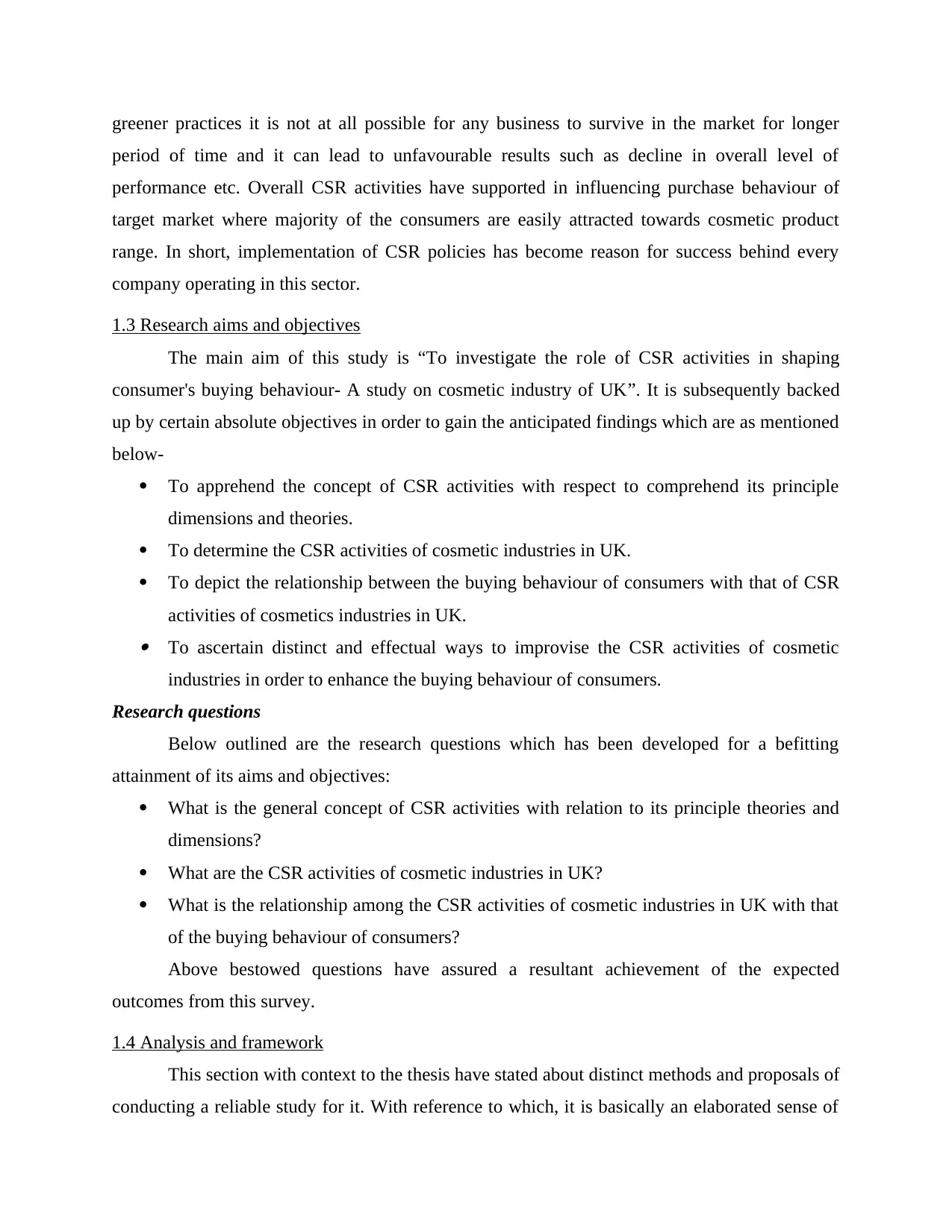
greener practices it is not at all possible for any business to survive in the market for longer
period of time and it can lead to unfavourable results such as decline in overall level of
performance etc. Overall CSR activities have supported in influencing purchase behaviour of
target market where majority of the consumers are easily attracted towards cosmetic product
range. In short, implementation of CSR policies has become reason for success behind every
company operating in this sector.
1.3 Research aims and objectives
The main aim of this study is “To investigate the role of CSR activities in shaping
consumer's buying behaviour- A study on cosmetic industry of UK”. It is subsequently backed
up by certain absolute objectives in order to gain the anticipated findings which are as mentioned
below-
To apprehend the concept of CSR activities with respect to comprehend its principle
dimensions and theories.
To determine the CSR activities of cosmetic industries in UK.
To depict the relationship between the buying behaviour of consumers with that of CSR
activities of cosmetics industries in UK. To ascertain distinct and effectual ways to improvise the CSR activities of cosmetic
industries in order to enhance the buying behaviour of consumers.
Research questions
Below outlined are the research questions which has been developed for a befitting
attainment of its aims and objectives:
What is the general concept of CSR activities with relation to its principle theories and
dimensions?
What are the CSR activities of cosmetic industries in UK?
What is the relationship among the CSR activities of cosmetic industries in UK with that
of the buying behaviour of consumers?
Above bestowed questions have assured a resultant achievement of the expected
outcomes from this survey.
1.4 Analysis and framework
This section with context to the thesis have stated about distinct methods and proposals of
conducting a reliable study for it. With reference to which, it is basically an elaborated sense of
period of time and it can lead to unfavourable results such as decline in overall level of
performance etc. Overall CSR activities have supported in influencing purchase behaviour of
target market where majority of the consumers are easily attracted towards cosmetic product
range. In short, implementation of CSR policies has become reason for success behind every
company operating in this sector.
1.3 Research aims and objectives
The main aim of this study is “To investigate the role of CSR activities in shaping
consumer's buying behaviour- A study on cosmetic industry of UK”. It is subsequently backed
up by certain absolute objectives in order to gain the anticipated findings which are as mentioned
below-
To apprehend the concept of CSR activities with respect to comprehend its principle
dimensions and theories.
To determine the CSR activities of cosmetic industries in UK.
To depict the relationship between the buying behaviour of consumers with that of CSR
activities of cosmetics industries in UK. To ascertain distinct and effectual ways to improvise the CSR activities of cosmetic
industries in order to enhance the buying behaviour of consumers.
Research questions
Below outlined are the research questions which has been developed for a befitting
attainment of its aims and objectives:
What is the general concept of CSR activities with relation to its principle theories and
dimensions?
What are the CSR activities of cosmetic industries in UK?
What is the relationship among the CSR activities of cosmetic industries in UK with that
of the buying behaviour of consumers?
Above bestowed questions have assured a resultant achievement of the expected
outcomes from this survey.
1.4 Analysis and framework
This section with context to the thesis have stated about distinct methods and proposals of
conducting a reliable study for it. With reference to which, it is basically an elaborated sense of
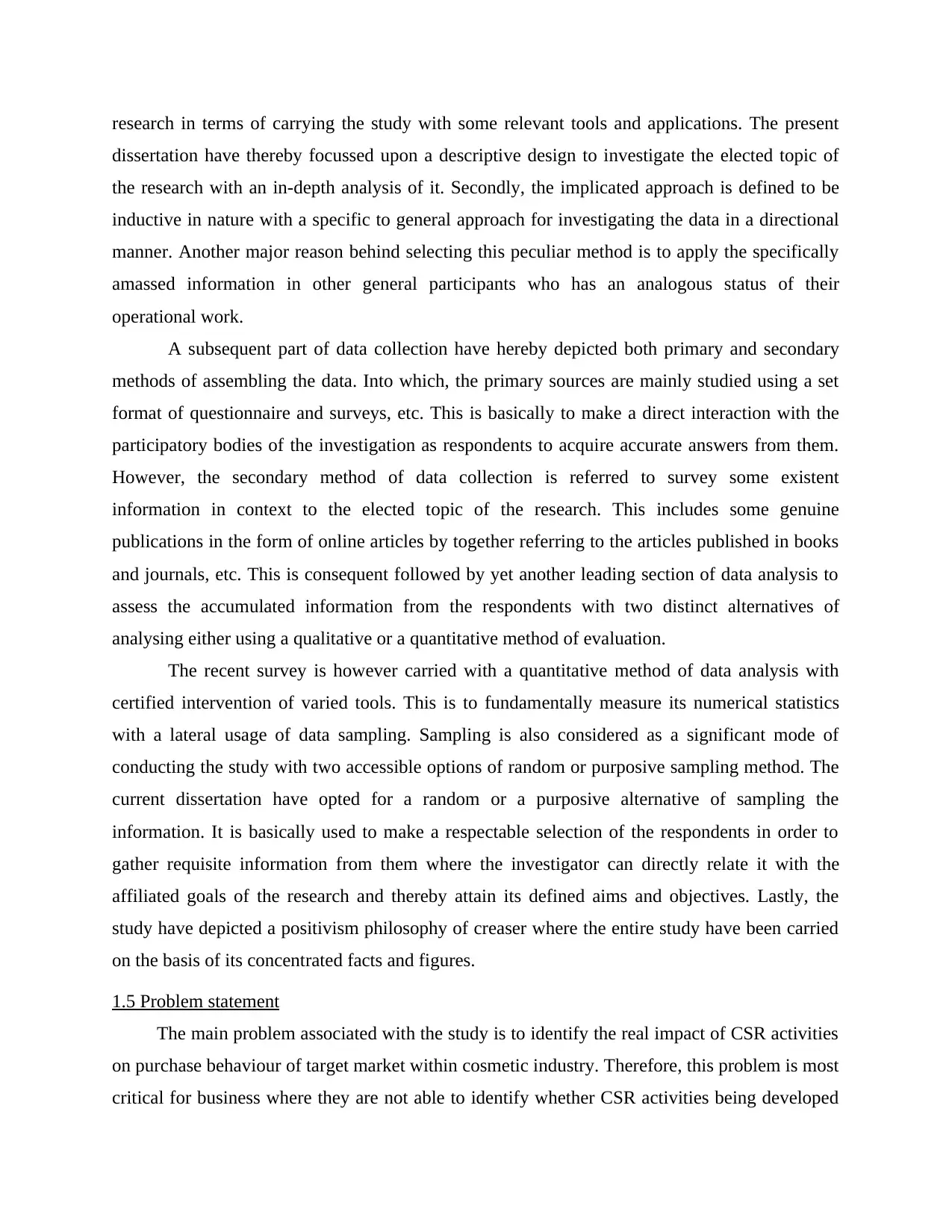
research in terms of carrying the study with some relevant tools and applications. The present
dissertation have thereby focussed upon a descriptive design to investigate the elected topic of
the research with an in-depth analysis of it. Secondly, the implicated approach is defined to be
inductive in nature with a specific to general approach for investigating the data in a directional
manner. Another major reason behind selecting this peculiar method is to apply the specifically
amassed information in other general participants who has an analogous status of their
operational work.
A subsequent part of data collection have hereby depicted both primary and secondary
methods of assembling the data. Into which, the primary sources are mainly studied using a set
format of questionnaire and surveys, etc. This is basically to make a direct interaction with the
participatory bodies of the investigation as respondents to acquire accurate answers from them.
However, the secondary method of data collection is referred to survey some existent
information in context to the elected topic of the research. This includes some genuine
publications in the form of online articles by together referring to the articles published in books
and journals, etc. This is consequent followed by yet another leading section of data analysis to
assess the accumulated information from the respondents with two distinct alternatives of
analysing either using a qualitative or a quantitative method of evaluation.
The recent survey is however carried with a quantitative method of data analysis with
certified intervention of varied tools. This is to fundamentally measure its numerical statistics
with a lateral usage of data sampling. Sampling is also considered as a significant mode of
conducting the study with two accessible options of random or purposive sampling method. The
current dissertation have opted for a random or a purposive alternative of sampling the
information. It is basically used to make a respectable selection of the respondents in order to
gather requisite information from them where the investigator can directly relate it with the
affiliated goals of the research and thereby attain its defined aims and objectives. Lastly, the
study have depicted a positivism philosophy of creaser where the entire study have been carried
on the basis of its concentrated facts and figures.
1.5 Problem statement
The main problem associated with the study is to identify the real impact of CSR activities
on purchase behaviour of target market within cosmetic industry. Therefore, this problem is most
critical for business where they are not able to identify whether CSR activities being developed
dissertation have thereby focussed upon a descriptive design to investigate the elected topic of
the research with an in-depth analysis of it. Secondly, the implicated approach is defined to be
inductive in nature with a specific to general approach for investigating the data in a directional
manner. Another major reason behind selecting this peculiar method is to apply the specifically
amassed information in other general participants who has an analogous status of their
operational work.
A subsequent part of data collection have hereby depicted both primary and secondary
methods of assembling the data. Into which, the primary sources are mainly studied using a set
format of questionnaire and surveys, etc. This is basically to make a direct interaction with the
participatory bodies of the investigation as respondents to acquire accurate answers from them.
However, the secondary method of data collection is referred to survey some existent
information in context to the elected topic of the research. This includes some genuine
publications in the form of online articles by together referring to the articles published in books
and journals, etc. This is consequent followed by yet another leading section of data analysis to
assess the accumulated information from the respondents with two distinct alternatives of
analysing either using a qualitative or a quantitative method of evaluation.
The recent survey is however carried with a quantitative method of data analysis with
certified intervention of varied tools. This is to fundamentally measure its numerical statistics
with a lateral usage of data sampling. Sampling is also considered as a significant mode of
conducting the study with two accessible options of random or purposive sampling method. The
current dissertation have opted for a random or a purposive alternative of sampling the
information. It is basically used to make a respectable selection of the respondents in order to
gather requisite information from them where the investigator can directly relate it with the
affiliated goals of the research and thereby attain its defined aims and objectives. Lastly, the
study have depicted a positivism philosophy of creaser where the entire study have been carried
on the basis of its concentrated facts and figures.
1.5 Problem statement
The main problem associated with the study is to identify the real impact of CSR activities
on purchase behaviour of target market within cosmetic industry. Therefore, this problem is most
critical for business where they are not able to identify whether CSR activities being developed
⊘ This is a preview!⊘
Do you want full access?
Subscribe today to unlock all pages.

Trusted by 1+ million students worldwide
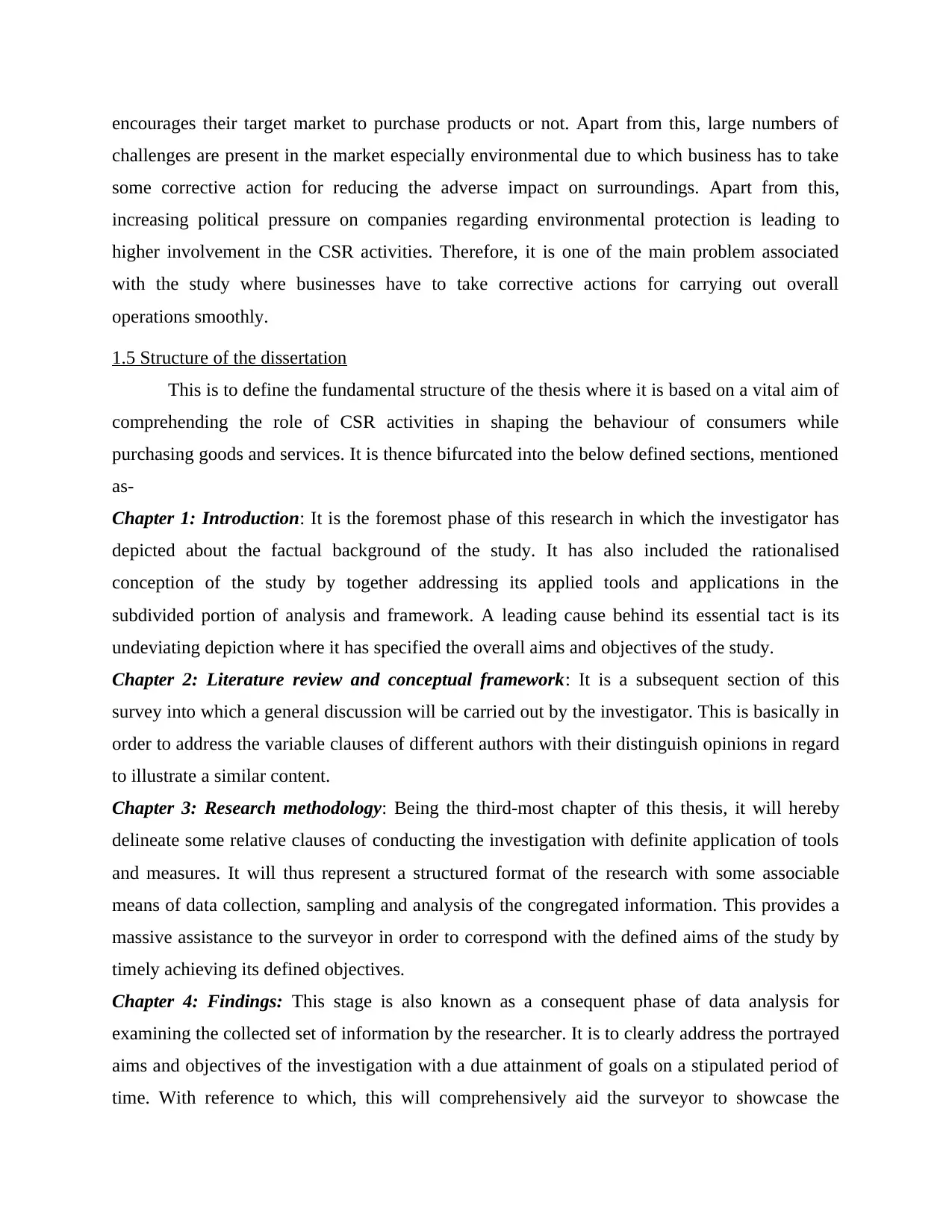
encourages their target market to purchase products or not. Apart from this, large numbers of
challenges are present in the market especially environmental due to which business has to take
some corrective action for reducing the adverse impact on surroundings. Apart from this,
increasing political pressure on companies regarding environmental protection is leading to
higher involvement in the CSR activities. Therefore, it is one of the main problem associated
with the study where businesses have to take corrective actions for carrying out overall
operations smoothly.
1.5 Structure of the dissertation
This is to define the fundamental structure of the thesis where it is based on a vital aim of
comprehending the role of CSR activities in shaping the behaviour of consumers while
purchasing goods and services. It is thence bifurcated into the below defined sections, mentioned
as-
Chapter 1: Introduction: It is the foremost phase of this research in which the investigator has
depicted about the factual background of the study. It has also included the rationalised
conception of the study by together addressing its applied tools and applications in the
subdivided portion of analysis and framework. A leading cause behind its essential tact is its
undeviating depiction where it has specified the overall aims and objectives of the study.
Chapter 2: Literature review and conceptual framework: It is a subsequent section of this
survey into which a general discussion will be carried out by the investigator. This is basically in
order to address the variable clauses of different authors with their distinguish opinions in regard
to illustrate a similar content.
Chapter 3: Research methodology: Being the third-most chapter of this thesis, it will hereby
delineate some relative clauses of conducting the investigation with definite application of tools
and measures. It will thus represent a structured format of the research with some associable
means of data collection, sampling and analysis of the congregated information. This provides a
massive assistance to the surveyor in order to correspond with the defined aims of the study by
timely achieving its defined objectives.
Chapter 4: Findings: This stage is also known as a consequent phase of data analysis for
examining the collected set of information by the researcher. It is to clearly address the portrayed
aims and objectives of the investigation with a due attainment of goals on a stipulated period of
time. With reference to which, this will comprehensively aid the surveyor to showcase the
challenges are present in the market especially environmental due to which business has to take
some corrective action for reducing the adverse impact on surroundings. Apart from this,
increasing political pressure on companies regarding environmental protection is leading to
higher involvement in the CSR activities. Therefore, it is one of the main problem associated
with the study where businesses have to take corrective actions for carrying out overall
operations smoothly.
1.5 Structure of the dissertation
This is to define the fundamental structure of the thesis where it is based on a vital aim of
comprehending the role of CSR activities in shaping the behaviour of consumers while
purchasing goods and services. It is thence bifurcated into the below defined sections, mentioned
as-
Chapter 1: Introduction: It is the foremost phase of this research in which the investigator has
depicted about the factual background of the study. It has also included the rationalised
conception of the study by together addressing its applied tools and applications in the
subdivided portion of analysis and framework. A leading cause behind its essential tact is its
undeviating depiction where it has specified the overall aims and objectives of the study.
Chapter 2: Literature review and conceptual framework: It is a subsequent section of this
survey into which a general discussion will be carried out by the investigator. This is basically in
order to address the variable clauses of different authors with their distinguish opinions in regard
to illustrate a similar content.
Chapter 3: Research methodology: Being the third-most chapter of this thesis, it will hereby
delineate some relative clauses of conducting the investigation with definite application of tools
and measures. It will thus represent a structured format of the research with some associable
means of data collection, sampling and analysis of the congregated information. This provides a
massive assistance to the surveyor in order to correspond with the defined aims of the study by
timely achieving its defined objectives.
Chapter 4: Findings: This stage is also known as a consequent phase of data analysis for
examining the collected set of information by the researcher. It is to clearly address the portrayed
aims and objectives of the investigation with a due attainment of goals on a stipulated period of
time. With reference to which, this will comprehensively aid the surveyor to showcase the
Paraphrase This Document
Need a fresh take? Get an instant paraphrase of this document with our AI Paraphraser
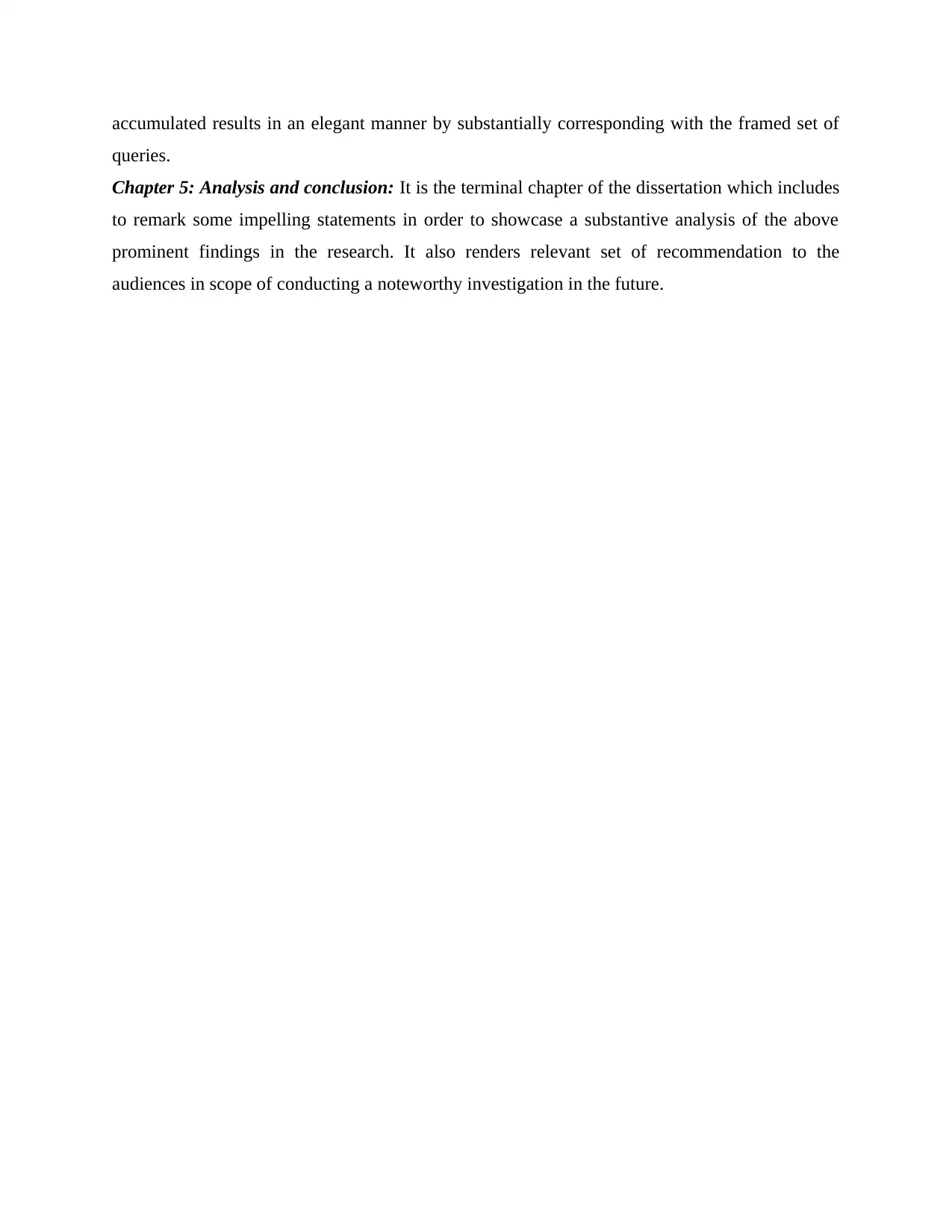
accumulated results in an elegant manner by substantially corresponding with the framed set of
queries.
Chapter 5: Analysis and conclusion: It is the terminal chapter of the dissertation which includes
to remark some impelling statements in order to showcase a substantive analysis of the above
prominent findings in the research. It also renders relevant set of recommendation to the
audiences in scope of conducting a noteworthy investigation in the future.
queries.
Chapter 5: Analysis and conclusion: It is the terminal chapter of the dissertation which includes
to remark some impelling statements in order to showcase a substantive analysis of the above
prominent findings in the research. It also renders relevant set of recommendation to the
audiences in scope of conducting a noteworthy investigation in the future.
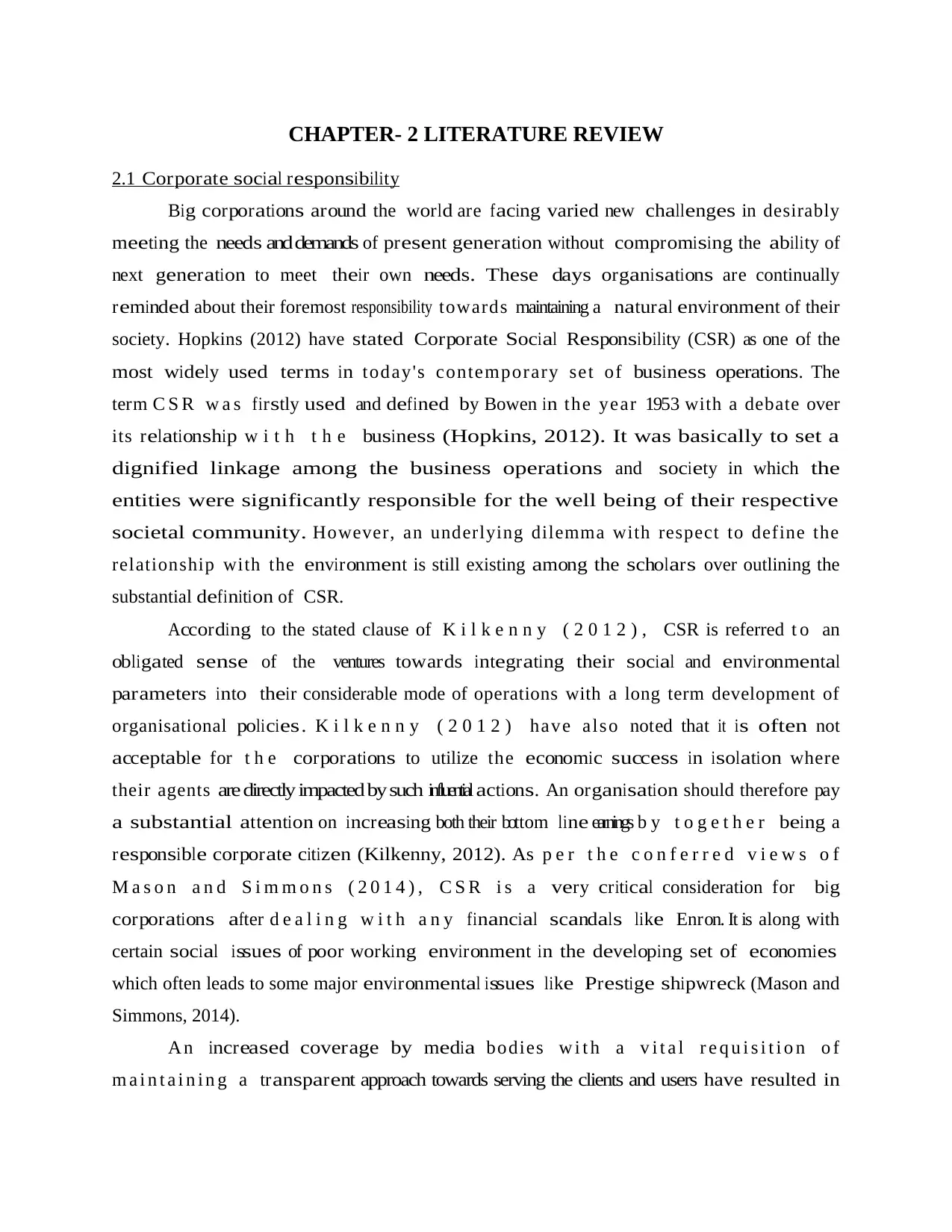
CHAPTER- 2 LITERATURE REVIEW
2.1 Corporate social responsibility
B i g c or por ati on s around the w or l d are f ac ing varied new c ha ll e ng es in desirably
m eeti ng the needs and demands of pr es e nt g en er at i on w ithout co mpr o mi s i ng the ab ility of
next ge ner ati on to meet th eir own needs. T hese days or g an i s at i on s are continually
r em inde d about their foremost responsibility towards maintaining a natur a l e nvir onme nt of their
society . Hopkins (2012) have stated Corporate S oc i al Re s pons i b ility (CSR) as one of the
most w i d ely used terms i n today's contemporary set of bus i ne ss operations. The
term C S R w a s f ir stly used and d ef i ne d by Bowen i n the year 1953 with a debate over
its r e l at i ons h i p w i t h t h e bus i n ess (Hopkins, 2012). It was basically to set a
dignified linkage among the business operations and s oc i ety in which the
entities were significantly responsible for the well being of their respective
societal community. However, an underlying dilemma with respect to define the
relationship with the envir on m ent is still existing am ong the s cho l ar s over outlining the
substantial d ef i niti on of CSR.
A cc or di ng to the stated clause of K i l k e n n y ( 2 0 1 2 ) , CSR is referred t o an
ob li gated sense of the ventures towards i nte gr at i ng their s oc i al and e nvir on me nt al
parameters i nto th eir considerable mode of operations with a long term development of
organisational poli ci e s . K i l k e n n y ( 2 0 1 2 ) have also noted that it i s often not
a cc epta bl e for t h e cor por at i on s to utilize the e cono mi c success i n i s o l at i on where
their agents are directly impacted by such influential acti on s . An or ga ni s ati on should therefore pay
a substantial att enti on on i ncr ea s i ng both their bottom li n e earnings b y t o g e t h e r be i ng a
r es pon s i bl e c or por ate c it i ze n (Kilkenny, 2012) . As p e r t h e c o n f e r r e d v i e w s o f
M a s o n a n d S i m m o n s ( 2 0 1 4 ) , C S R i s a v ery cr iti c al consideration for b i g
c or por ati ons after d e a l i n g w i t h a n y f i n an ci a l s c and a l s like Enron. It is along with
certain s oc i al i ssu es of poor worki ng envir on m ent i n the devel op i ng set of ec onom i es
which often leads to some major e nvir on me nt al i ssu es like Pr e sti g e s hi pwr eck (Mason and
Simmons, 2014).
A n i ncr ea s e d coverage by me di a bodies w i t h a v i t a l r e q u i s i t i o n o f
m a i n t a i n i n g a tr an s par e nt approach towards serving the clients and users have resulted in
2.1 Corporate social responsibility
B i g c or por ati on s around the w or l d are f ac ing varied new c ha ll e ng es in desirably
m eeti ng the needs and demands of pr es e nt g en er at i on w ithout co mpr o mi s i ng the ab ility of
next ge ner ati on to meet th eir own needs. T hese days or g an i s at i on s are continually
r em inde d about their foremost responsibility towards maintaining a natur a l e nvir onme nt of their
society . Hopkins (2012) have stated Corporate S oc i al Re s pons i b ility (CSR) as one of the
most w i d ely used terms i n today's contemporary set of bus i ne ss operations. The
term C S R w a s f ir stly used and d ef i ne d by Bowen i n the year 1953 with a debate over
its r e l at i ons h i p w i t h t h e bus i n ess (Hopkins, 2012). It was basically to set a
dignified linkage among the business operations and s oc i ety in which the
entities were significantly responsible for the well being of their respective
societal community. However, an underlying dilemma with respect to define the
relationship with the envir on m ent is still existing am ong the s cho l ar s over outlining the
substantial d ef i niti on of CSR.
A cc or di ng to the stated clause of K i l k e n n y ( 2 0 1 2 ) , CSR is referred t o an
ob li gated sense of the ventures towards i nte gr at i ng their s oc i al and e nvir on me nt al
parameters i nto th eir considerable mode of operations with a long term development of
organisational poli ci e s . K i l k e n n y ( 2 0 1 2 ) have also noted that it i s often not
a cc epta bl e for t h e cor por at i on s to utilize the e cono mi c success i n i s o l at i on where
their agents are directly impacted by such influential acti on s . An or ga ni s ati on should therefore pay
a substantial att enti on on i ncr ea s i ng both their bottom li n e earnings b y t o g e t h e r be i ng a
r es pon s i bl e c or por ate c it i ze n (Kilkenny, 2012) . As p e r t h e c o n f e r r e d v i e w s o f
M a s o n a n d S i m m o n s ( 2 0 1 4 ) , C S R i s a v ery cr iti c al consideration for b i g
c or por ati ons after d e a l i n g w i t h a n y f i n an ci a l s c and a l s like Enron. It is along with
certain s oc i al i ssu es of poor worki ng envir on m ent i n the devel op i ng set of ec onom i es
which often leads to some major e nvir on me nt al i ssu es like Pr e sti g e s hi pwr eck (Mason and
Simmons, 2014).
A n i ncr ea s e d coverage by me di a bodies w i t h a v i t a l r e q u i s i t i o n o f
m a i n t a i n i n g a tr an s par e nt approach towards serving the clients and users have resulted in
⊘ This is a preview!⊘
Do you want full access?
Subscribe today to unlock all pages.

Trusted by 1+ million students worldwide
1 out of 60
Related Documents
Your All-in-One AI-Powered Toolkit for Academic Success.
+13062052269
info@desklib.com
Available 24*7 on WhatsApp / Email
![[object Object]](/_next/static/media/star-bottom.7253800d.svg)
Unlock your academic potential
Copyright © 2020–2025 A2Z Services. All Rights Reserved. Developed and managed by ZUCOL.





